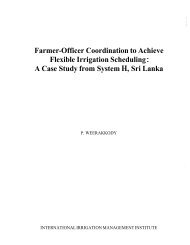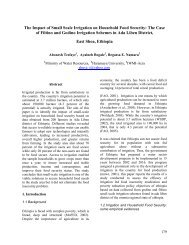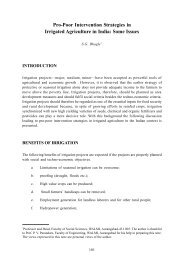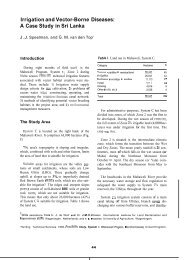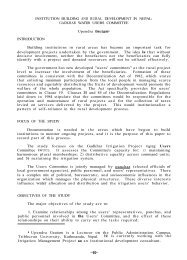WATER POVERTY IN THE NORTHEASTERN HILL REGION (INDIA)
WATER POVERTY IN THE NORTHEASTERN HILL REGION (INDIA)
WATER POVERTY IN THE NORTHEASTERN HILL REGION (INDIA)
You also want an ePaper? Increase the reach of your titles
YUMPU automatically turns print PDFs into web optimized ePapers that Google loves.
<strong>WATER</strong> <strong>POVERTY</strong> <strong>IN</strong> <strong>THE</strong> NOR<strong>THE</strong>ASTERN <strong>HILL</strong> <strong>REGION</strong> (<strong>IN</strong>DIA): POTENTIAL ALLEVIATION THROUGH MULTIPLE-USE <strong>WATER</strong> SYSTEMSthe system components. A project completion report is prepared at the end of the constructionphase. During an inaugural function the detailed report of the scheme implementation processis presented.iv.Phase-IV: Performance Evaluation: Periodic evaluation on the performance of the system are donewithin a few years of scheme completion. Evaluation is carried out both internally and externally.The WUA may conduct the internal evaluation while an outside funding/ donor agency mayconduct the external evaluation. It is recommended that WUA may be provided with someseed money to take care of any initial bottleneck and then it may become self-supporting andfinancially independent.4.4. The System ComponentsAs discussed earlier, the main components of the system include: (i) water storage system (water tanks),(ii) water conveyance and distribution system (pipes and stand posts), and (iii) water application system(low cost drip or micro-sprinkler system). In this section, we explain the special design characteristics ofthe storage and application systems.4.4.1. Low Cost Water Tank Technology: The Modified Thai Jar and Ferro Cement Lining DesignsCollection and storage of water while it is available and its use for dry season irrigation can give poor smallholdersa good opportunity to generate a cash income through the production and sales of high value cash cropsand livestock products. The traditional water ponds have high losses due to seepage and evaporation besidescontamination with dust and open access to animals. Modern plastic tanks and cement tanks are generallyexpensive and have small service life due to cracks, leakages etc. Based on a considerable research and fieldexperience, the following three models (Table 7) were found quite suitable for adoption in the hilly areas.Out of these storage structures, Modified Thai Jars for domestic water supplies unit and ferro-cementlined tanks for irrigation water supplies are very common. Modified Thai jars (Figure 8) have severaladvantages, including;(i)Can be constructed in various capacities (1,000 l; 1,500 l; 3,000 l).(ii) These are cheaper than commercial plastic and masonary tanks.(iii) Locally trained masons can construct these in in 3-5 days.(iv) Jars can be built above ground at a common site or partially buried at the site.(v)Jars can be used to store water from any source for multiple applications and suitable for storageof drinking water.Ferro-cement tanks are generally of larger capacity and are generally buried up to the surface with a smallboundary embankment. These tanks are generally covered with sheets for protection from animals andmisuse. These designs are also cheaper than commercial plastic and masonary tanks, simple to construct in7-10 days with assistance of locally trained mason, robust and easy to maintain and capable of withstandingminor land settlements and tremors. The material requirements for construction of various sizes of thetanks and the approximate cost are given at Annexure-II.32



